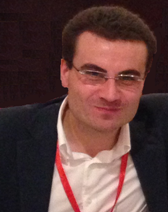
Marco Di Renzo
Paris-Saclay University/ CNRS, France
Smart Radio Environments and Environmental AI - Wireless Networks Design in the Era of Deep Learning: Model-Based, AI-Based, or Both?
Abstract
Future wireless networks will be more than allowing people, mobile devices, and objects to communicate with each other. Future wireless networks will be turned into a distributed intelligent wireless communications, sensing, and computing platform, which, besides communications, will be capable of sensing the environment to realize the vision of smart living in smart cities by providing them with context-awareness capabilities, of locally storing and processing information in order to accommodate the time critical, ultra-reliable, and energy efficient delivery of data, of accurately localizing people and objects in environments and scenarios where the global positioning system is not an option. Future wireless networks will have to fulfill the challenging requirement of interconnecting the physical and digital worlds in a seamless and sustainable manner. To fulfill these challenging requirements, it is apparent that it is not sufficient anymore to rely solely on wireless networks whose logical operation is software-controlled and optimized (software networks). The wireless environment itself needs to be turned into a software-reconfigurable entity, whose operation is optimized to enable uninterrupted connectivity. Future wireless networks need a smart radio environment, i.e., a wireless environment that is turned into a reconfigurable space that plays an active role in transferring and processing information. This emerging concept is referred to as “smart radio environment”. The concept of smart radio environment is a fundamental paradigm shift with respect to the design of current wireless networks. In current wireless networks, broadly speaking, the environment, i.e., the set of physical objects that alter the propagation of the radio waves, is not controllable. The environment ignores the underlying process of transferring and processing information, and is perceived, in addition, as an adversary to the communication process, i.e., it has usually a negative effect that needs to be counteracted by the transmitters and receivers. The advent of emerging electromagnetic materials and devices, such as the reconfigurable metasurfaces, reconfigurable reflectarrays, reconfigurable large-intelligent surfaces, etc. challenges this status quo, but asks for new methodologies for modeling, analyzing, and optimizing wireless networks, and, in addition, equips them with a distributed sensing platform for enabling their smart and adaptive optimization by capitalizing on reinforcement, transfer, and federated learning methods. In this talk, we will overview the challenges of this emerging wireless scenario, and will present some results on the application of deep transfer learning for networks optimization. The usual approach to use deep learning consists of acquiring large amount of empirical data about the system behavior and employ it for performance optimization (data-driven approach). We believe, however, that the application of deep learning to communication networks design and optimization offers more possibilities. As opposed to other fields of science, such as image classification and speech recognition, mathematical models for communication networks optimization are very often available, even though they may be simplified and inaccurate. We believe that this a priori expert knowledge, which has been acquired over decades of intense research, cannot be dismissed and ignored. In the talk, in particular, we put forth a new approach that capitalizes on the availability of (possibly simplified or inaccurate) theoretical models, in order to reduce the amount of empirical data to use and the complexity of training artificial neural networks (ANNs). We concretely show, with the aid of some examples, that synergistically combining prior expert knowledge based on analytical models and data-driven methods constitutes a suitable approach towards the design and optimization of communication systems and networks with the aid of deep learning based on ANNs.
Biography
Marco DI RENZO was born in L'Aquila, Italy, in 1978. He received the Laurea (cum laude) and Ph.D. degrees in electrical engineering from the University of L'Aquila, Italy, in 2003 and 2007, respectively, and the Habilitation à Diriger des Recherches (Doctor of Science) degree from University Paris-Sud, France, in 2013. Since 2010, he has been a Chargé de Recherche CNRS (CNRS Associate Professor) in the Laboratory of Signals and Systems (L2S) of Paris-Saclay University - CNRS, CentraleSupélec, Univ Paris Sud, Paris, France. He serves as the Associate Editor-in-Chief of IEEE Communications Letters, and as an Editor of IEEE Transactions on Communications, and IEEE Transactions on Wireless Communications. He is a Distinguished Lecturer of the IEEE Vehicular Technology Society and IEEE Communications Society, and a Senior Member of the IEEE. He is a recipient of several awards, including the 2013 IEEE-COMSOC Best Young Researcher Award for Europe, Middle East and Africa, the 2013 NoE-NEWCOM# Best Paper Award, the 2014-2015 Royal Academy of Engineering Distinguished Visiting Fellowship, the 2015 IEEE Jack Neubauer Memorial Best System Paper Award, the 2015-2018 CNRS Award for Excellence in Research and Ph.D. Supervision, the 2016 MSCA Global Fellowship (declined), the 2017 SEE-IEEE Alain Glavieux Award, the 2018 IEEE-COMSOC Young Professional in Academia Award, and 7 Best Paper Awards at IEEE conferences (2012 and 2014 IEEE CAMAD, 2013 IEEE VTC-Fall, 2014 IEEE ATC, 2015 IEEE ComManTel, 2017 IEEE SigTelCom, 2018 INISCOM).